Loewe Bild i.55 Review
Loewe bursts back onto the scene with a typically gorgeous and uniquely upgradable 4K OLED TV
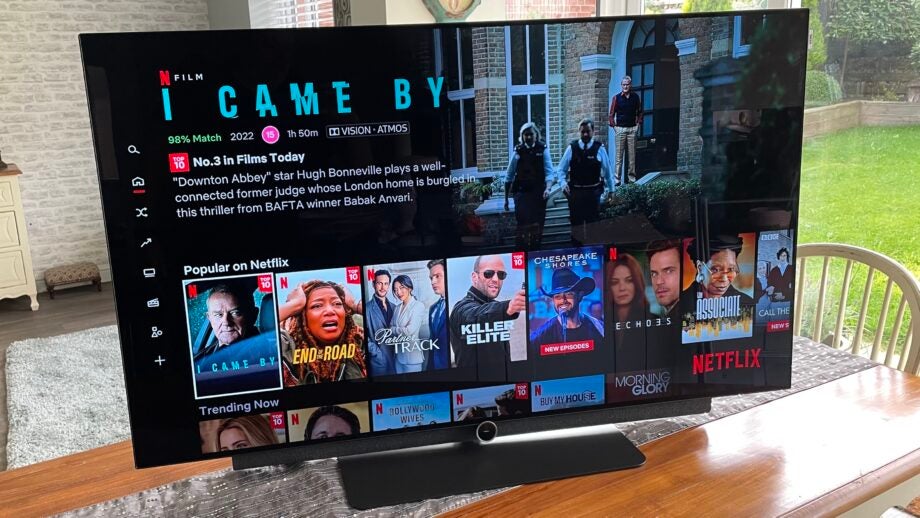

Verdict
Another gorgeously designed OLED TV from Loewe that conjures up an impressive audio and picture performance, though the lack of some advanced gaming features, higher peak brightness and expensive price means this is a TV for specific audience. A class act nonetheless.
Pros
- Beautiful design and build
- Multiple stand/mount and speaker options
- Strong sound quality
Cons
- More expensive than less designer rivals
- Can’t play 4K/120Hz gaming feeds
- Pictures lack brightness by today’s OLED standards
Key Features
- 55-inch 4K OLED screenOLED technology enables each pixel to produce its own light and colour independently of its neighbours
- Two Audio upgrade optionsSupports Klang Bar i soundbar or the much larger Klang Bar 5mr
- Multiple stand and mount optionsA choice of the basic desktop stand, floorstanding pole mount, a floor to ceiling pole mount, or wall mount options
- Four HDMI portsFour HDMI inputs support variable refresh rates over a limited frequency range, ALLM and Dolby Vision games at 60Hz
- HDRSupports Dolby Vision, HDR10 and HLG HDR
Introduction
After what Gwyneth Paltrow might politely call a ‘conscious uncoupling’ from the UK market back in 2019, a restructured, reinvigorated Loewe brand is now well and truly back on the UK AV scene.
And right on the front line of Loewe’s renewed UK charge is its Bild i range of TVs: models that seek to combine all of the traditional Loewe attractions of outstanding, bespoke design with a new-found nimbleness when it comes to delivering the sort of performance standards and features that today’s fast-moving TV market demands.
Availability
- UKRRP: £2999
- USAunavailable
- EuropeRRP: €2999
- Canadaunavailable
- AustraliaRRP: AU$4999
The Loewe Bild i.55 is available now in the UK and EU, as well as Australia. In the UK it costs £2,999, in the EU it costs €2,999.00, and in Australia it costs AU$4,999. If you want something bigger, the 65-inch Bild i.65 costs £3,899 / €3,899 / AU$6,499. Loewe does not currently distribute its TVs in North America.
It should be stressed that these are starting prices as one of the Bild i range’s star attractions is its ability to be fitted to different stand/mount options and be partnered with more powerful integrated sound options.
The mounting options include a desktop stand, a floor-standing pole-style stand, wall hanging brackets, and even an ultra stylish pole that runs the full height of your room, from floor to ceiling.
The most elegant speaker upgrade is the marvellously named Klang Bar i, which costs £299 extra and has been specially designed to attach seamlessly to the Bild i TVs’ bottom edge as it goes about adding more power, more speakers and a more direct feel to the TV’s built-in audio system.
You can also attach Loewe’s much bigger, standalone Klang Bar 5mr soundbar if you wish, though this sits on a shelf attachment for one of the pole mounts rather than being a fully integrated, specialist solution like the Bar i. I’ll actually be looking at the Bar i as part of this review.
Design
- Premium build and finish
- Upgrade speaker and stand options
- Extensive cable management
The first thing die-hard fans of Loewe TVs of old will be happy to hear is the new 55-inch Bild i.55 retains two classic Loewe design traits: the designer clothing-like Loewe brand tag on its right hand side, and Loewe’s distinctive large chrome-edged circular IR receptor and LED display hanging off its bottom edge.
It’s also great to see that Loewe has lost none of its appetite for truly premium build quality. Every model is still built in Loewe’s factory in Kronach, Germany, and combines an ultra-thin bezel with extensive use of metal and an unusual but very welcome splash of high quality fabric covering the TV’s relatively chunky central section (which houses connections, processing and built-in speakers).
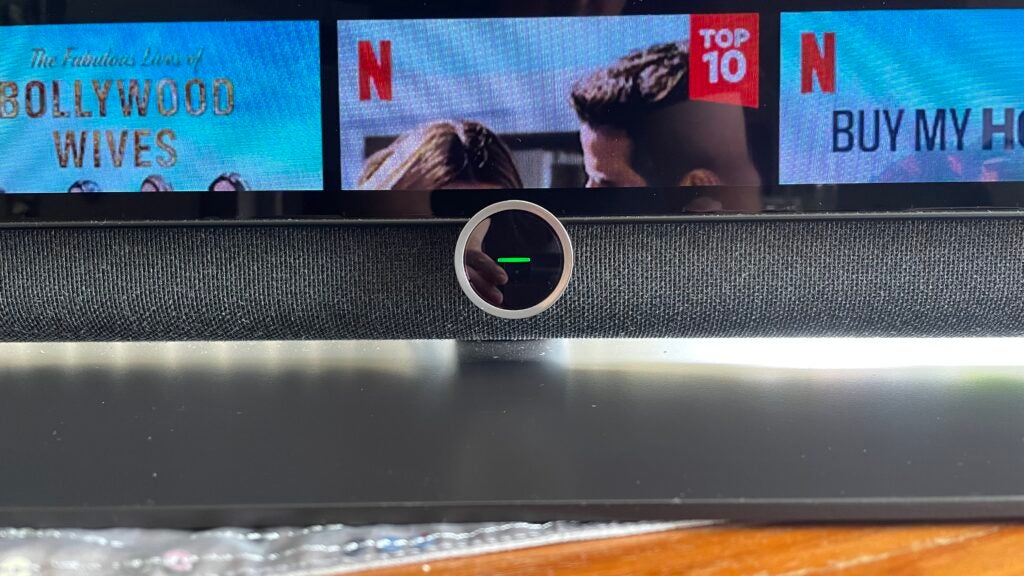
As well as looking lovely in its own right, it also perfectly matches the fabric finish of the optional Klang Bar i, meaning the soundbar blends in perfectly when you attach its wrap-around form to the TV’s bottom edge.
The heavy duty basic desktop plate stand is as imperiously built as the TV, while the pole-style floorstand and full room height pole mount options add serious drama to the Bild i.55’s otherwise impeccably minimalistic presence.
As you would expect with a TV that trades on its appearance as much as the Bild i.55, all of its various mounting options go to great lengths to provide channelling for all your cables.
Features
- 4K WRGB OLED panel
- Audio upgrade options
- Dolby Atmos sound
The first thing to establish about the Loewe Bild i.55 is that it doesn’t use one of the new Micro Lens Array OLED panels found in LG’s new flagship G3 OLED TV, or the Quantum Dot OLED technology in Samsung’s S95C and S90C OLED TVs. It’s a straight WRGB panel of the sort that’s had relative small year-on-year improvements for years before the new brightness boosting technologies sauntered into town.
It might have been nice if Loewe had gone for an OLED panel with a built-in heat sink to help it handle a bit more brightness than the 736 nits I measured using a white HDR test window that covered 10% of the TV’s screen. That’s 100 to 150 nits or so below what I’ve seen from the current WRGB OLEDs from the likes of Sony and LG, and only around half the brightness achieved by the G3 and S95C.
I’ve been reviewing TVs for long enough to know that there’s much more to good picture quality than simple brightness.
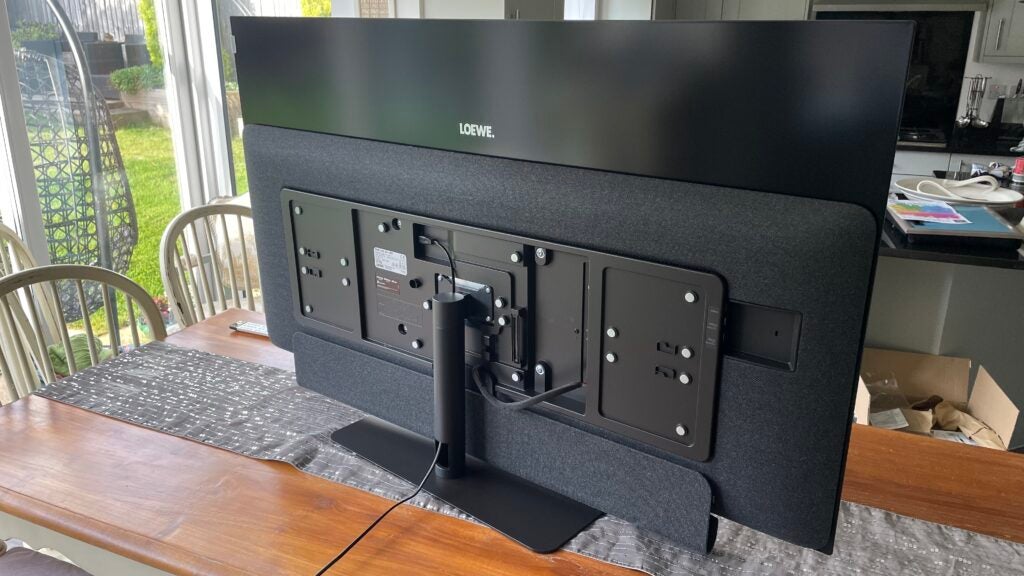
The most unusual feature of the Bild i.55 beyond the stand/mount and audio upgrade options I’ve mentioned has to be its DR+ built-in video recording system. This lets you record losslessly up to 1TB of video from the built-in tuners. This feature is less likely to have wide appeal in streaming-obsessed times, but it works well enough and I’m sure there are some who will take advantage of it.
Intriguingly, Loewe has moved away from its own proprietary smart TV engine on the Bild i.55, turning to Hisense’s VIDAA platform instead. This makes sense given the difficulties a relatively small brand like Loewe is bound to face with securing native app support from all the streaming services – especially as VIDAA has now progressed from its second-tier status into a smart platform that runs slickly and stably, and covers most of the key apps today’s TV buyers demand.
At the time of reviewing the only major exception I spotted was Apple TV+ – but Loewe has since added the app and users can now access it.
The Bild i.55 supports three flavours of high dynamic range through its HDMI ports: Dolby Vision, HDR10 and HLG. There’s no HDR10+ support, which is a slight shame given Panasonic and Philips cater for all four HDR formats. Many other brands also only support Dolby Vision at the expense of HDR10+ too, though – and HDR10+ content currently remains much rarer than Dolby Vision content.
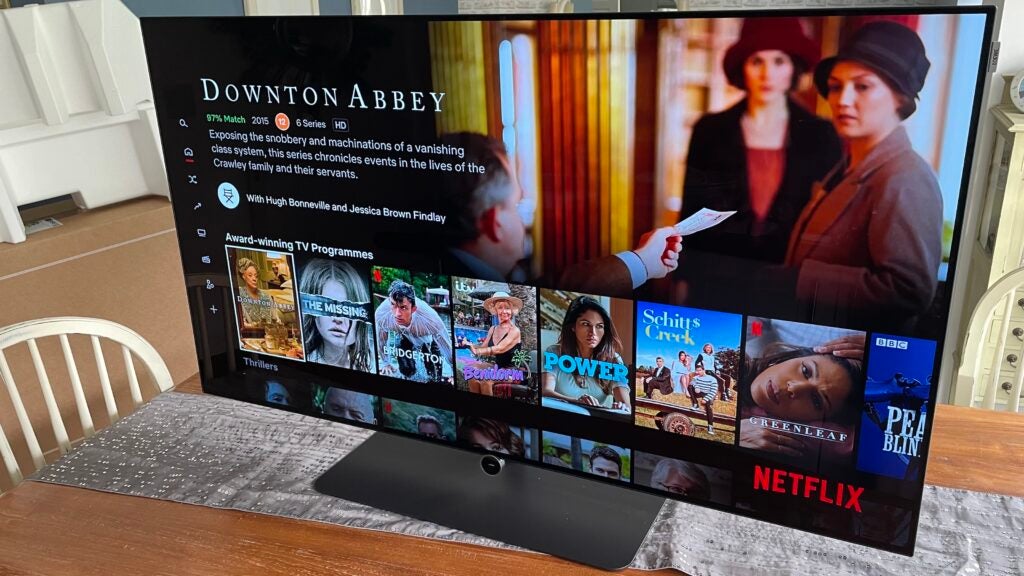
The Bild i.55’s Dolby connection extends to Dolby Atmos playback, which it can also pass on losslessly via HDMI eARC to compatible soundbars and AV receivers.
Not everything about the Bild i.55’s four HDMI ports is quite up to the specification I’d hope for on a premium TV, as they’re only capable of handling 18Gbps of data. This means no support for the 4K/120Hz signals gamers can output from the PS5, Xbox Series X and high-end PC graphics cards.
That’s not to say the Bild i.55 is a total bust for gaming; it does still support variable refresh rates in a limited 48 – 60Hz range, auto low latency mode (ALLM) switching as your console or PC switches between video and game sources; and Dolby Vision gaming up to 60Hz.
There is one further bit of bad news for gamers in the shape of a 43.5ms lag in rendering image data when using the TV’s Game mode. That’s more than four times longer than the latest TVs from some rivals take, and will be enough to cost you a few deaths in Call Of Duty or make game worlds feel a touch unresponsive.
Delving into the the Bild i.55’s picture features reveals a reasonable amount of the usual set up suspects, including various motion processing options, noise reduction and so on. One striking thing about the way the set up menus are organised is how similar they appear to those used on Hisense’s most recent high-end TVs, suggesting a deeper collaboration than merely the use of Hisense’s VIDAA smart platform.
Picture Quality
- Gorgeously deep, natural black levels
- Impressive sharpness and detailing
- Not as bright as the latest OLED panels
The brightness measurements I reported earlier didn’t lie: it’s clear to the naked eye the Loewe Bild i.55 is not as bright as the latest advanced OLED TVs I’ve seen from Samsung and LG – not even close. But this is true also of any new mid-range OLED TV from LG, Samsung, Sony, Hisense, Philips et al that doesn’t use either MLA technology or Samsung’s second-gen QD-OLED technology.
It’s absolutely not the case that the Bild i.55 is some sort of old school outlier. And in the context of all those other traditional WRGB OLED TVs still around this year, the Bild i.55 is a very enjoyable watch.
For starters, its black levels are as impeccably deep, rich and natural in tone as any you’ll find anywhere in the OLED world. What’s more, with most of its presets this black level prowess is married to excellent finesse and subtlety when it comes to reproducing subtle colour and greyscale detail in even the darkest picture corners.
The only exception to this shadow detail prowess occurs when you’re watching Dolby Vision sources (especially using the most accurate ‘Dark’ Dolby Vision preset), with which you become aware of quite noticeable crushing out of subtle details in dark areas. The Bild i.55 is not the only TV I’ve seen in recent times that’s suffered with this Dolby Vision issue, so it’s perhaps more something Dolby ought to be investigating rather than a fault specific to Loewe’s TV.
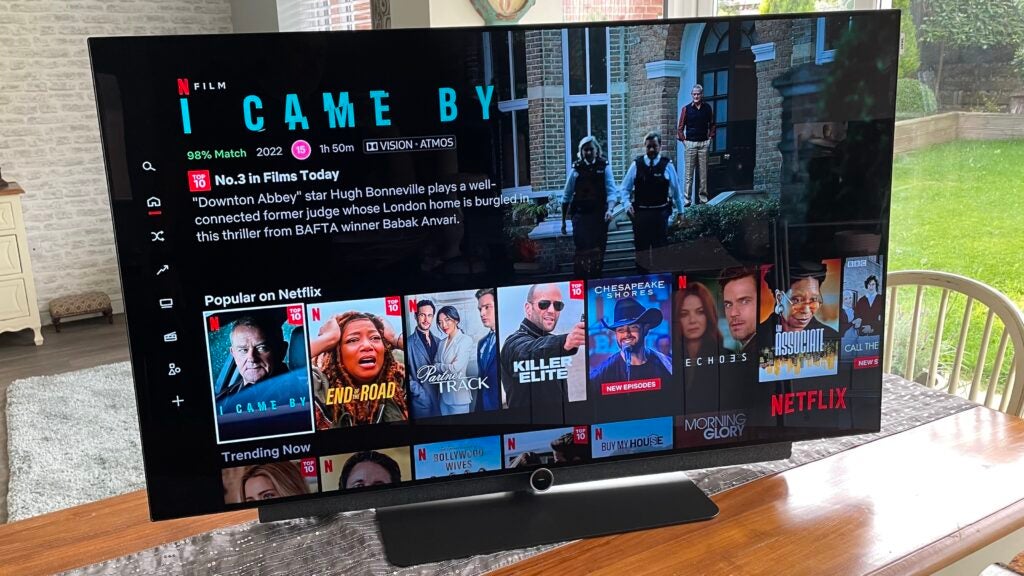
Subtle details are delivered in dark scenes without being accompanied by fizzing or blocking artefacts, too, suggesting good processing competence/panel control when it comes to handling near black image content. The set’s rich, black tones provide the perfect counterpoint, too, for the Bild i.55’s beautifully rich, bold colour reproduction.
There’s more than enough tonal subtlety and balance in this colour performance to ensure that pictures never look forced, cartoonish or otherwise unnatural in any preset, and I didn’t detect any major issues with banding in areas of fine HDR blending.
Colours don’t undergo a major shift or any brightness reduction if you watch the Bild i.55 from a severe angle, either, while the image processing’s precision at picking the right shade for the right pixel contributes to a picture that feels pleasingly dense, three-dimensional and detailed.
It’s not quite as mind-bogglingly sharp with either native 4K sources or upscaled HD as one or two rival OLED pictures, most notably those achieved by Philips and Samsung, but its marginally softer pictures arguably actually look more natural. Especially as they don’t remotely feel short of texture or 4K quality.
While the richness and balance of the Bild i.55’s pictures guarantees a gorgeous viewing experience with really any video source thrown at it, it does need to be said that as well as being substantially less bright than 2023’s new OLED ‘hero’ TVs, its pictures are actually a little less bright and punchy than even those of most of today’s traditional WRGB OLED TVs. A limitation that inevitably restricts the colour volumes the screen can hit, and the intensity of the HDR experience you get with both small bright highlights and full screen bright HDR images.
The set’s subtlety and balance really does provide good compensation for its slightly limited brightness, but it’s an issue that may be particularly worth bearing in mind if you’re looking for a TV for a very bright room.
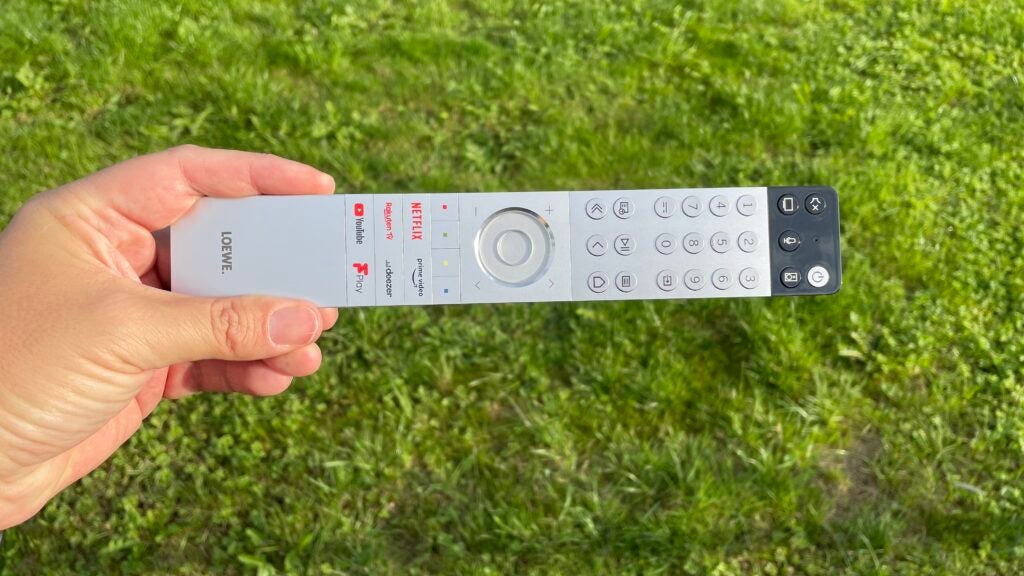
One other picture quality niggle concerns the bild i.55’s motion handling with 24p sources. Judder and a reduction in resolution when showing camera pans and moving objects are more noticeable than I’d like with no motion processing in play, but most of the Bild i.55’s motion processing options cause so many unwanted side effects that they end up being more distracting to watch than the native judder and blurring.
Fortunately, just one of the motion options available, appropriately called Film, proves sensitive enough to save the day, otherwise we’d have had to knock a full mark off the TV’s overall score.
Sound Quality
- Lovely rounded, powerful sound
- Rich, impactful sound – especially with the Klang Bar i
- Slight lack of expansion during the loudest movie moments
Loewe has a long history of combining its uncompromising approach to design and build quality with superior audio performance, so it’s great to find that if the Bild i.55 is anything to go by, Loewe has lost none of its audio touch during its brief time away from the UK TV business.
Starting with the set’s default 2 x 20W performance, the speakers can go loud enough to sound cinematic without succumbing to harshness, drop outs or other distortions. On the contrary, the louder you push them, the richer and more detailed they start to sound, and the more you start to appreciate how open and expansive their mid-range is.
Voices always sound ultra clear without becoming disconnected from their wider movie mix context, and the sound projects well enough out from the TV’s bodywork to create an at least respectable sense of extra space and location detailing when playing Dolby Atmos mixes.
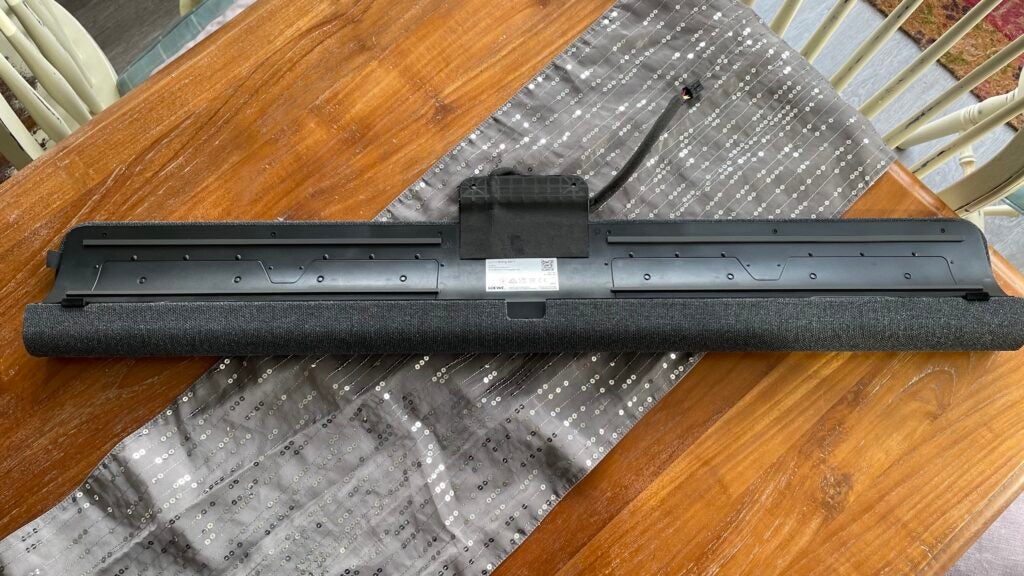
Good though the Bild i.55 sounds out of the box, though, I’d say the Klang Bar i is well worth adding if you can afford the £299 extra. This not only adds a whopping 80W of power to proceedings, but delivers that power through an array of forward facing drivers that hang behind a smart felt cover under the TV’s bottom edge.
The result is an immediately much more room-filling, direct sound that makes the world of the film or TV show you’re watching seem far more alive and immersive. The forward-facing speakers of the Bar i also create a much larger soundstage that doesn’t feel trapped inside the soundbar’s compact form. It even manages to create a mild sense of height when listening to Dolby Atmos soundtracks.
Bass reaches deeper with the Klang Bar i than it does in the basic two-channel built in speaker configuration. Voices can occasionally sound locked inside the Bar i, so that they don’t seem to be coming from the pictures on the screen, and surprisingly the Bar i’s usually resolute amounts of power and impact can fall away a bit during really loud, dense sound track moments. Overall, though, the Bild i.55 is a seriously good audio performer in both its standard and Klang Bar i configurations.
Latest deals
Should you buy it?
Unique build quality and upgrade options: If you want a beautifully built TV that lets you upgrade its sound quality as and when you wish and lets you choose from a variety of stylish mounting options, the Loewe Bild i.55 is uniquely qualified for its money.
It’s not a great option for cutting edge gamers: The Bild i.55 doesn’t support 4K/120Hz gaming and its input lag in Game mode is a little too high for really responsive, competitive play.
Final Thoughts
The Loewe Bild i.55 is a deeply lovely TV. From its pristine, beautifully constructed bodywork and unique design and audio upgrade options through to its often beautiful (if not spectacularly so) pictures and clean, potent sound quality it proves that Loewe has lost none of its uniqueness and feel premium feel during its brief time away from the TV game.
The fact that even the cheapest version of the Bild i.55 costs hundreds of pounds more than the 55-inch versions of this year’s ultra-bright new Samsung S95C and LG G3 OLED TVs does mean that you need to be invested in the whole premium Bild i.55 package rather than just being a straight-up picture quality junky.
That’s always been the case with Loewe, though, and when the package is as class an act as the Bild i.55 it’s impossible not to embrace the return of a brand that’s brave enough to bring something a bit different to the TV world.
How we test
We test every television we review thoroughly over an extended period of time. We use industry standard tests to compare features properly. We’ll always tell you what we find. We never, ever, accept money to review a product.
Find out more about how we test in our ethics policy.
Tested for more than a week
Tested with real world use
FAQs
VIDAA is a smart TV system and interface designed by Hisense, but licensed to other brands.
Every pixel in an OLED screen produces its own light, resulting in black level consistency and local contrast control you can’t get with LCD TVs. Though OLEDs typically can’t get as bright as LCD TVs.
You can mount it on a floorstanding pole, a floor to ceiling pole, and a wall mount as well as its desktop solution. And you can add a screw-on Klang Bar i soundbar, or attach the much larger 5mr soundbar to a support shelf that can be attached to the TV’s pole stand.
Full specs
Sustainability
Trusted Reviews’ holds the fact that global warming is not a myth as a core value and will continuously endeavour to help protect our planet from harm in its business practices.
As part of this mission, whenever we review a product we send the company a series of questions to help us gauge and make transparent the impact the device has on the environment.
We currently haven’t received answers to the questions on this product, but will update this page the moment we do. You can see a detailed breakdown of the questions we ask and why in our sustainability info page.







